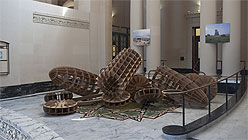Art & Soul in downtown Oakland is a weekend festival that presents art and live music — it is an annual staple in the community. For this year’s event, Oakland-based artist Terry Furry has curated a series of projects within the historic architecture of City Hall, on view during public hours for the month of August. The impressive roster of artists includes Taro Hattori, Mayumi Hamanaka, and Tracey Snelling, among others. It is an extraordinary opportunity to take in both an impressive selection of artworks and this classic building reminiscent of the city’s early Beaux Arts grandeur.
Hattori’s sculpture, Penetration (2012), presents a compelling contrast within these sweeping marble spaces, designed by New York-based architecture firm Palmer and Hornbostel in 1910. Made from unadorned cardboard, Penentration resembles a stylized war machine when fully assembled, like a torpedo on wheels. Initially the work was to be installed at the base of the grand staircase, beneath the bronze dedication plaque and the American flag. But upon seeing the work fully assembled, the artist was compelled to take it apart, favoring the appearance of its destruction within the building’s mannered spaces. The disarray of the reorganized sculpture provokes more interesting questions than might have otherwise developed. What arises from this chaotic display in the heart of civic leadership? Between media images of police misconduct during last year’s Occupy protests and the looming federal takeover of the Oakland Police Department in light of its failure to comply with decade-old court ordered reforms, the work presents a quiet commentary on the city’s state of affairs. Whether or not the artist intended these observations is unclear, though the larger body of work associated with this sculpture indicates his studied observations around the complexities of bureaucracy.
Penetration (the first iteration at Oakland City Hall) from Taro Hattori on Vimeo.
With this work, Oakland-based Hattori, who possesses degrees in new media from the Art Institute of Chicago and clinical psychology from Tokyo’s Sophia University, considers how “invisible power structures penetrate everyday life,” and function as both a limitation and a support system. The sculpture featured at City Hall has made the rounds and appeared in a variety of environments that reflect the challenges of garnering permission, including Area 51, a Marijuana field, and the grounds of a nuclear power plant. In each case, the work is installed and documented with either photography or video; the dialogue that precedes the installation is as essential to the work as the sculpture itself. At present, Hattori is negotiating permission to realize the project in additional sites, including a public school and a Mormon temple. In each iteration of the project, the work exposes the heavily restricted nature of so-called public spaces and the challenge of gaining access to them.

Taro Hattori, Penetration, 2012.
A pair of photographs is presented alongside Hattori’s sculpture at City Hall. In one image, the work is set within an expansive desert, in another a pair of nuclear reactors tower above the work in an open field. Though there are no fences or signage to indicate otherwise, it is evident that the artist has managed to infiltrate a space that would otherwise be inaccessible. How he manages to gain access is unclear — interestingly, though the artist considers the dialogue intrinsic to the work, none is displayed here. The absence of any explanation around access reflects, in effect, the opacity of the controlled environments Hattori has selected.



